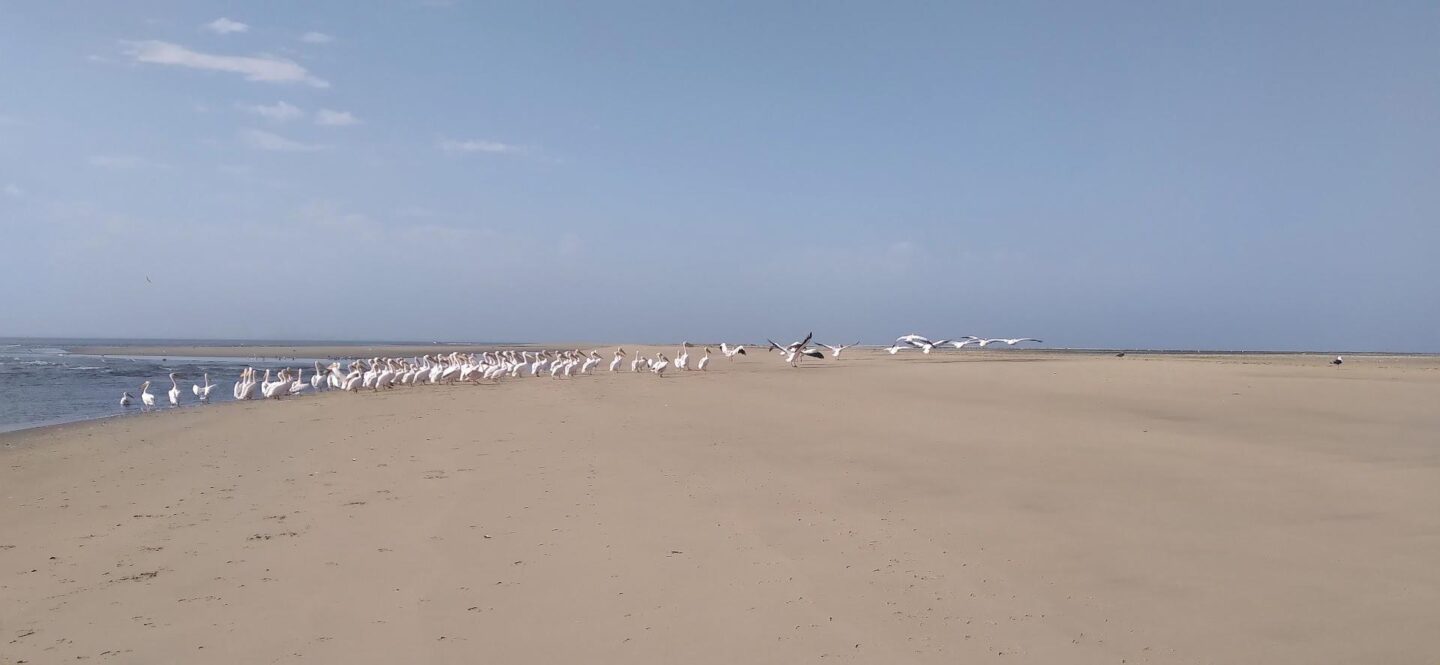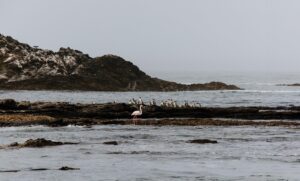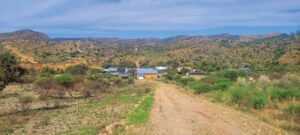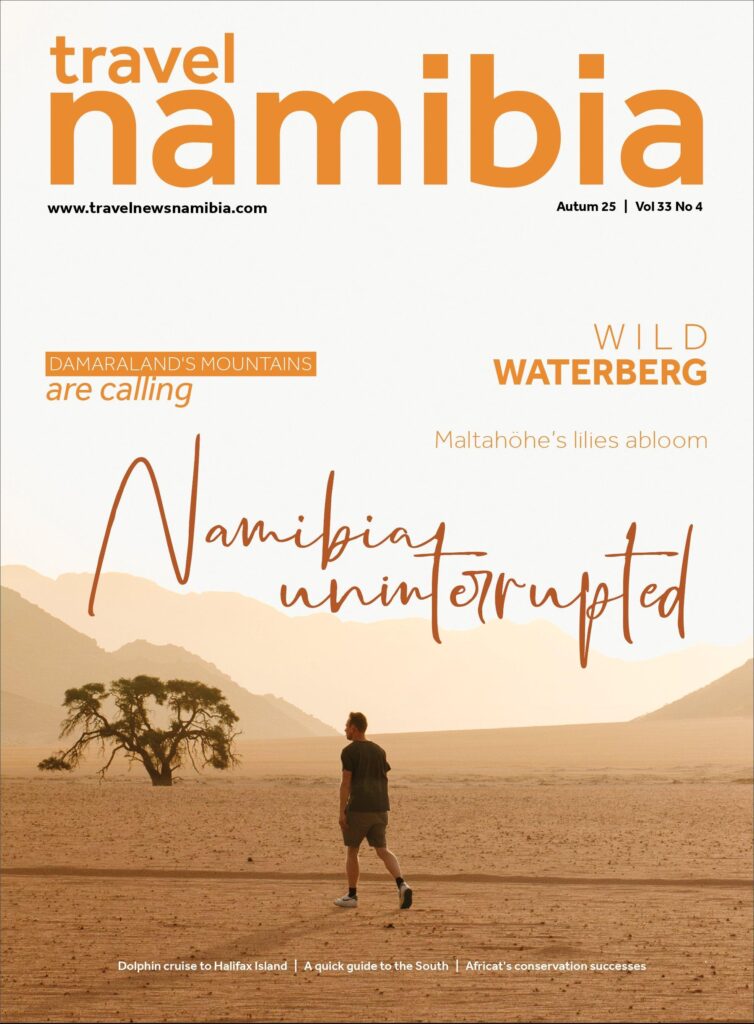

Exploring Walvis Bay’s
Wild Side
Text Le Roux van Schalkwyk | Photographs Le Roux van Schalkwyk
From the Autumn 2025 issue
The Pelican Point Guided Hike is a new initiative, offering adventurers a unique way to explore the beauty of Walvis Bay’s lagoon and RAMSAR site. Founded by Kelly Beukes, an avid hiker and nature enthusiast, this trek takes participants along the western edge of the lagoon. What sets this experience apart is the opportunity to witness marine and birdlife up close, away from the noise and distractions of the modern world. From playful seals and elegant flamingos to the dramatic shipwreck resting on the shore, every step of the journey reveals something remarkable.
It’s a crisp, clear morning on the Atlantic coast as we start our hike along the western edge of the Walvis Bay Lagoon. The port town, with its towering dock cranes, can be seen to the east across the mirror-like surface of the lagoon. The drive here took us past the evaporation ponds of the Walvis Bay Salt Works, where the pink water reflected brightly in the early morning sun – a scenic start to the exciting adventure that lies ahead.
The scent of the ocean is the perfect companion as we begin our trek along the soft sand of the beach. Our first wildlife sighting is Klaus, the name given to an obese seal that has realised the best buffet can be found at the salt works’ pump station. Klaus’ personality is almost as big as his body; he is a regular here and entertains guests with his playful dances in the water as he fills his tummy.
From here, the hike takes us through marshy areas, where the group has to wade through some ankle-deep water – one of the reasons why these hikes are only done at low tide. Otherwise, the water is too high. The cool water is a refreshing sensation and adds to the experience of walking on the beach, as common terns fly overhead.
The hike takes us past an oyster farm, where we spot solitary jackals patrolling up and down the beach, searching for eggs and easy prey. We also see some oystercatchers, which are quite common along this stretch of the lagoon – an excellent opportunity to observe them up close.
Further down the beach, we pass the old oyster farm. The wooden infrastructure and debris from buildings that were blown over in the last storm are still visible, making for a great photo opportunity.
In the distance, a flamboyance of flamingos awaits. As we get closer, we watch their slender legs half-submerged as they rhythmically dip their curved beaks into the water, searching for food. Their vibrant pink hues stand out against the deep blue of the lagoon, and every so often, they take off in a graceful, synchronised dance, their wings flashing black and crimson as they lift into the sky.
After wading through the deepest water yet – just below our knees – we reach the wreck of a Norwegian shipping vessel. Apparently, it caught fire and was beached here.
As the hike progresses, a seal’s head occasionally breaks the water’s surface, its curious eyes peering at us before vanishing beneath the waves. Flocks of cormorants line the sandbanks, drying their wings in the sun, while pelicans glide effortlessly above, their large beaks poised to scoop up fish.
Approaching Pelican Point, the sound of barking grows louder. The massive seal colony comes into view – a bustling, chaotic mass of movement and noise. Hundreds of Cape fur seals lounge on the sand or play in the shallow waters, their sleek bodies glistening in the sunlight. Some tumble over each other in playful wrestling matches, while others rest in the warmth of the morning sun. The scent of salt and fish hangs thick in the air, mingling with the earthy aroma of damp sand.
Beyond the seals, the lighthouse stands tall at Pelican Point – a historical remnant of the region’s shipping past. These days, it operates as accommodation. Pelican Point marks the end of the hike, where a well-deserved picnic awaits. A spread of cheeses, cold meats, quesadillas, fruits, drinks, and something sweet to round off the meal. Chairs to rest our weary legs are a welcome sight as we sit and reflect on the wonderful experience.
Hiking is part of my journey, something that I love. It’s a way to experience a new landscape in a different and much more intimate way. Walking gives you time to see everything from a slower, more immersive perspective.”
“I started organising this hike when I realised no guided hikes were available in the area. This stretch of beach is so isolated and teeming with marine life – pelicans, flamingos, and more. The best part is that you can see them up close, without the noise of cars or crowds, just our small group of hikers. It’s a completely different experience from what’s typically on offer, and I wanted to share that with others,” explains Kelly, the hike’s founder.
The Pelican Point Guided Hike is roughly 12 km long. Along the way, guests can expect to see flamingos, pelicans, oystercatchers, plovers, terns, seagulls, cormorants, pied avocets, little egrets, greater egrets, and more. Although this regular hike is not specifically aimed at birders, those with a keen interest in birdwatching can request to have local bird expert Kobus Bekker lead the tour with prior arrangements.
The Pelican Point Guided Hike takes 2.5 – 3 hours. Guests are picked up from the marina at 08:00 and can expect to be dropped off around noon. There is also an option to combine the hike with a Sandwich Harbour tour with Photo Ventures, in which case hikers will be picked up from Pelican Point. TN
COST
Pelican Point Guided Hike: N$1,250 per person (includes transport to and from Walvis Bay).
Optional Sandwich Harbour Tour: N$2,550 per person.
WHAT TO BRING
• A small backpack (If you don’t have one, Kelly can provide one).
• Snacks for the walk.
• A sunhat and sunscreen.
• Water shoes (if you prefer not to walk barefoot).
• Water will be provided on the hike.
To book the Pelican Point Guided Hike, contact Kelly at +264 81 423 1961 or [email protected].
More to explore

Discover Airlines launches a new direct flight between Windhoek and Munich






